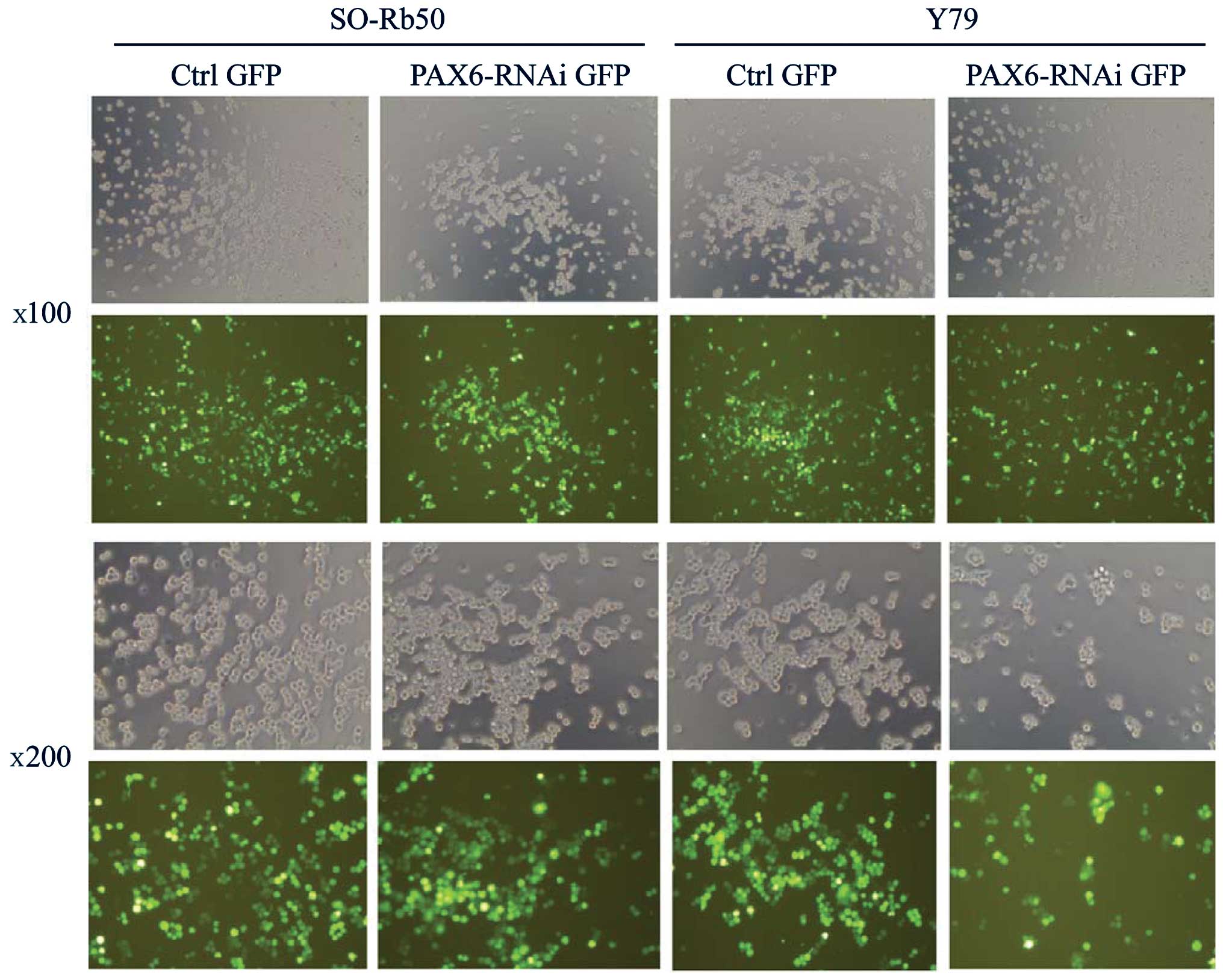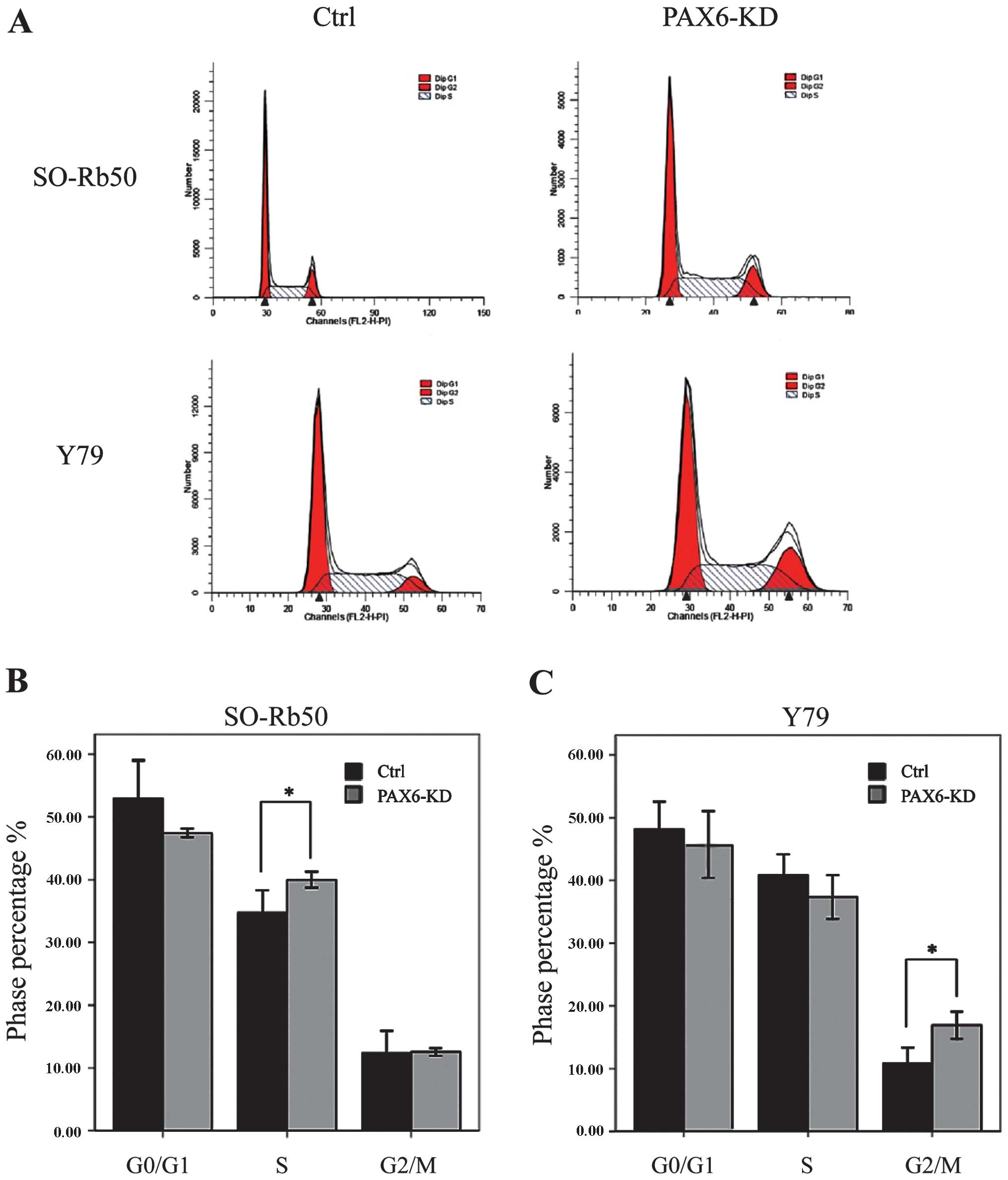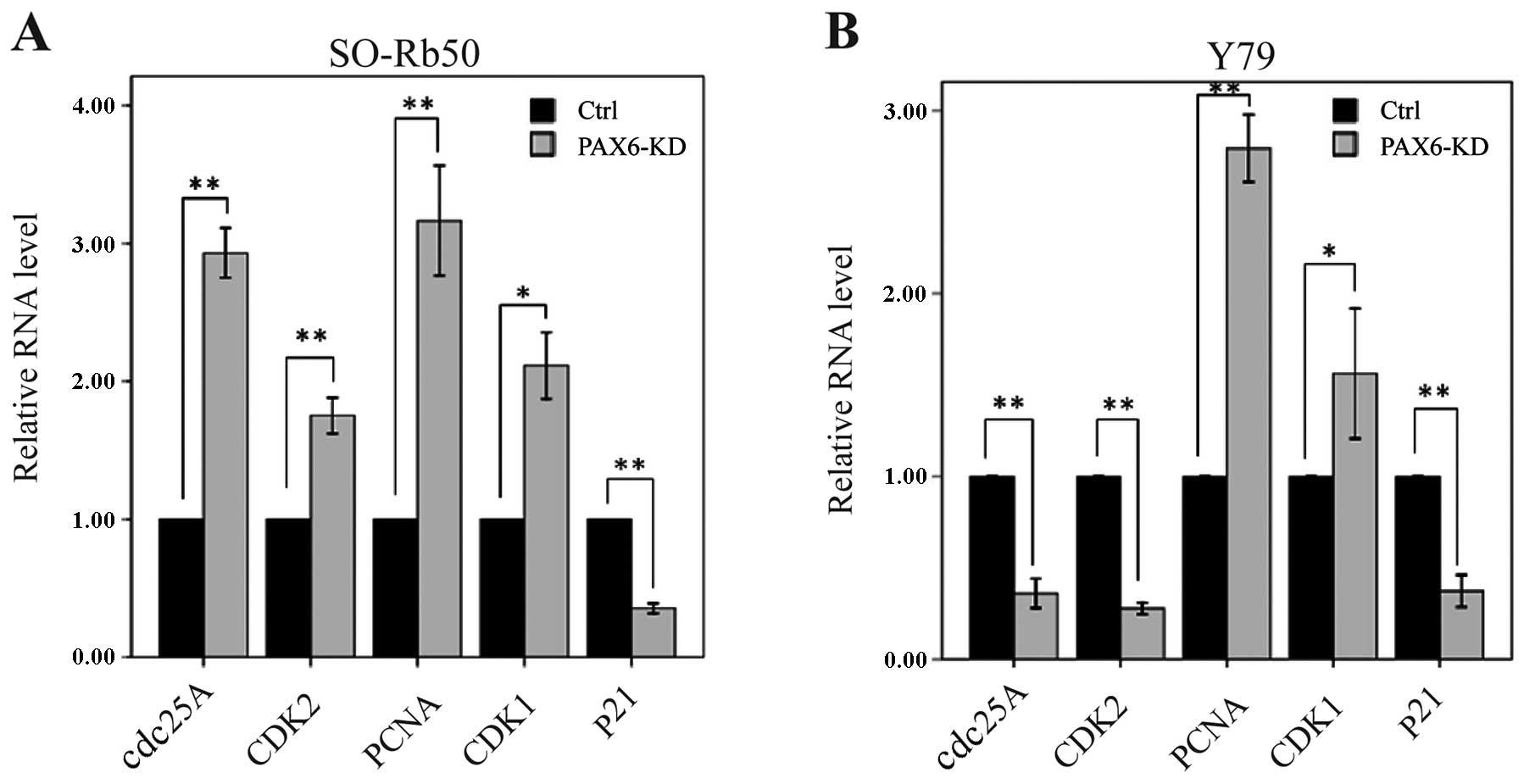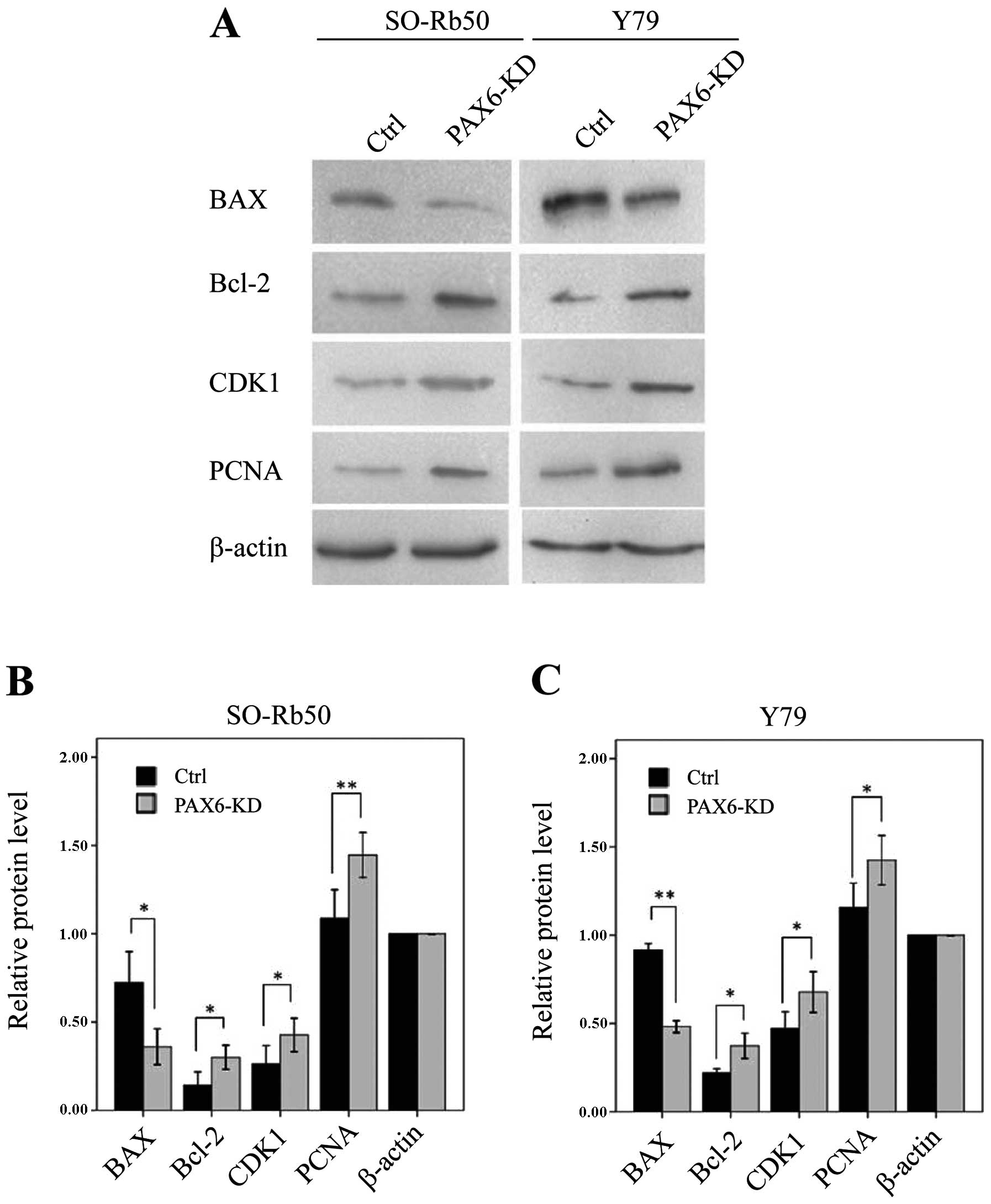|
1
|
Jordan T, Hanson I, Zaletayev D, et al:
The human PAX6 gene is mutated in two patients with aniridia. Nat
Genet. 1:328–332. 1992. View Article : Google Scholar : PubMed/NCBI
|
|
2
|
Quiring R, Walldorf U, Kloter U and
Gehring WJ: Homology of the eyeless gene of Drosophila to
the small eye gene in mice and aniridia in humans. Science.
265:785–789. 1994.PubMed/NCBI
|
|
3
|
Kogawa M, Hisatake K, Atkins GJ, et al:
The paired-box homeodomain transcription factor Pax6 binds to the
upstream region of the TRAP gene promoter and suppresses receptor
activator of NF-kappaB ligand (RANKL)-induced osteoclast
differentiation. J Biol Chem. 288:31299–31312. 2013. View Article : Google Scholar
|
|
4
|
Hart AW, Mella S, Mendrychowski J, van
Heyningen V and Kleinjan DA: The developmental regulator Pax6 is
essential for maintenance of islet cell function in the adult mouse
pancreas. PLoS One. 8:e541732013. View Article : Google Scholar : PubMed/NCBI
|
|
5
|
Hsieh YW and Yang XJ: Dynamic Pax6
expression during the neurogenic cell cycle influences
proliferation and cell fate choices of retinal progenitors. Neural
Dev. 4:322009. View Article : Google Scholar : PubMed/NCBI
|
|
6
|
Livesey FJ and Cepko CL: Vertebrate neural
cell-fate determination: lessons from the retina. Nat Rev Neurosci.
2:109–118. 2001. View
Article : Google Scholar : PubMed/NCBI
|
|
7
|
Shaham O, Menuchin Y, Farhy C and
Ashery-Padan R: Pax6: a multi-level regulator of ocular
development. Prog Retin Eye Res. 31:351–376. 2012. View Article : Google Scholar : PubMed/NCBI
|
|
8
|
Marquardt T, Ashery-Padan R, Andrejewski
N, Scardigli R, Guillemot F and Gruss P: Pax6 is required for the
multipotent state of retinal progenitor cells. Cell. 105:43–55.
2001. View Article : Google Scholar
|
|
9
|
Maulbecker CC and Gruss P: The oncogenic
potential of Pax genes. EMBO J. 12:2361–2367. 1993.PubMed/NCBI
|
|
10
|
Sachdeva UM and O’Brien JM: Understanding
pRb: toward the necessary development of targeted treatments for
retinoblastoma. J Clin Invest. 122:425–434. 2012. View Article : Google Scholar : PubMed/NCBI
|
|
11
|
Xu XL, Fang Y, Lee TC, et al:
Retinoblastoma has properties of a cone precursor tumor and depends
upon cone-specific MDM2 signaling. Cell. 137:1018–1031. 2009.
View Article : Google Scholar : PubMed/NCBI
|
|
12
|
Cvekl A, Yang Y, Chauhan BK and Cveklova
K: Regulation of gene expression by Pax6 in ocular cells: a case of
tissue-preferred expression of crystallins in lens. Int J Dev Biol.
48:829–844. 2004. View Article : Google Scholar : PubMed/NCBI
|
|
13
|
Schedl A, Ross A, Lee M, et al: Influence
of PAX6 gene dosage on development: overexpression causes severe
eye abnormalities. Cell. 86:71–82. 1996. View Article : Google Scholar : PubMed/NCBI
|
|
14
|
Bai SW, Li B, Zhang H, et al: Pax6
regulates proliferation and apoptosis of human retinoblastoma
cells. Invest Ophthalmol Vis Sci. 52:4560–4570. 2011. View Article : Google Scholar : PubMed/NCBI
|
|
15
|
Li L, Li B, Zhang H, et al: Lentiviral
vector-mediated PAX6 overexpression promotes growth and inhibits
apoptosis of human retinoblastoma cells. Invest Ophthalmol Vis Sci.
52:8393–8400. 2011. View Article : Google Scholar : PubMed/NCBI
|
|
16
|
Xin GH, Zhao XH, Liu D, et al: Effect of
VEGF-targeted antisense gene therapy on retinoblastoma cell line
SO-RB50 in vitro and in vivo. Int J Ophthalmol. 5:440–447.
2012.PubMed/NCBI
|
|
17
|
Sreenivasan S, Thirumalai K and
Krishnakumar S: Expression profile of genes regulated by curcumin
in Y79 retinoblastoma cells. Nutr Cancer. 64:607–616. 2012.
View Article : Google Scholar : PubMed/NCBI
|
|
18
|
Zhao B, Li B, Bai S, et al: Effects of
matrine on proliferation and apoptosis of cultured retinoblastoma
cells. Graefes Arch Clin Exp Ophthalmol. 250:897–905. 2012.
View Article : Google Scholar : PubMed/NCBI
|
|
19
|
Reid TW, Albert DM, Rabson AS, et al:
Characteristics of an established cell line of retinoblastoma. J
Natl Cancer Inst. 53:347–360. 1974.PubMed/NCBI
|
|
20
|
Marconett CN, Morgenstern TJ, San Roman
AK, Sundar SN, Singhal AK and Firestone GL: BZL101, a phytochemical
extract from the Scutellaria barbata plant, disrupts
proliferation of human breast and prostate cancer cells through
distinct mechanisms dependent on the cancer cell phenotype. Cancer
Biol Ther. 10:397–405. 2010.PubMed/NCBI
|
|
21
|
Shi T, Mazumdar T, Devecchio J, et al:
cDNA microarray gene expression profiling of hedgehog signaling
pathway inhibition in human colon cancer cells. PLoS One. 5:pii:
e13054. 2010.PubMed/NCBI
|
|
22
|
Wang T, Zhao R, Wu Y, et al: Hepatitis B
virus induces G1 phase arrest by regulating cell cycle genes in
HepG2.2.15 cells. Virol J. 8:2312011. View Article : Google Scholar : PubMed/NCBI
|
|
23
|
Johnstone RW, Ruefli AA and Lowe SW:
Apoptosis: a link between cancer genetics and chemotherapy. Cell.
108:153–164. 2002. View Article : Google Scholar : PubMed/NCBI
|
|
24
|
Fulda S: Tumor resistance to apoptosis.
Int J Cancer. 124:511–515. 2009. View Article : Google Scholar
|
|
25
|
Kashiwagi Y, Kato N, Sassa T, et al:
Cotylenin A inhibits cell proliferation and induces apoptosis and
PAX6 mRNA transcripts in retinoblastoma cell lines. Mol Vis.
16:970–982. 2010.PubMed/NCBI
|
|
26
|
Ouyang J, Shen YC, Yeh LK, et al: Pax6
overexpression suppresses cell proliferation and retards the cell
cycle in corneal epithelial cells. Invest Ophthalmol Vis Sci.
47:2397–2407. 2006. View Article : Google Scholar : PubMed/NCBI
|
|
27
|
Zhang X, Huang CT, Chen J, et al: Pax6 is
a human neuroectoderm cell fate determinant. Cell Stem Cell.
7:90–100. 2010. View Article : Google Scholar : PubMed/NCBI
|
|
28
|
Davis N, Yoffe C, Raviv S, et al: Pax6
dosage requirements in iris and ciliary body differentiation. Dev
Biol. 333:132–142. 2009. View Article : Google Scholar : PubMed/NCBI
|
|
29
|
Estivill-Torrus G, Pearson H, van
Heyningen V, Price DJ and Rashbass P: Pax6 is required to regulate
the cell cycle and the rate of progression from symmetrical to
asymmetrical division in mammalian cortical progenitors.
Development. 129:455–466. 2002.PubMed/NCBI
|
|
30
|
Gotz M, Stoykova A and Gruss P: Pax6
controls radial glia differentiation in the cerebral cortex.
Neuron. 21:1031–1044. 1998. View Article : Google Scholar : PubMed/NCBI
|
|
31
|
Warren N, Caric D, Pratt T, et al: The
transcription factor, Pax6, is required for cell proliferation and
differentiation in the developing cerebral cortex. Cereb Cortex.
9:627–635. 1999. View Article : Google Scholar : PubMed/NCBI
|
|
32
|
Berger J, Berger S, Tuoc TC, et al:
Conditional activation of Pax6 in the developing cortex of
transgenic mice causes progenitor apoptosis. Development.
134:1311–1322. 2007. View Article : Google Scholar : PubMed/NCBI
|
|
33
|
Duncan MK, Haynes JI II, Cvekl A and
Piatigorsky J: Dual roles for Pax-6: a transcriptional repressor of
lens fiber cell-specific beta-crystallin genes. Mol Cell Biol.
18:5579–5586. 1998.PubMed/NCBI
|
|
34
|
Grindley JC, Davidson DR and Hill RE: The
role of Pax-6 in eye and nasal development. Development.
121:1433–1442. 1995.PubMed/NCBI
|
|
35
|
Richardson J, Cvekl A and Wistow G: Pax-6
is essential for lens-specific expression of zeta-crystallin. Proc
Natl Acad Sci USA. 92:4676–4680. 1995. View Article : Google Scholar : PubMed/NCBI
|
|
36
|
Walther C and Gruss P: Pax-6, a murine
paired box gene, is expressed in the developing CNS. Development.
113:1435–1449. 1991.PubMed/NCBI
|
|
37
|
Zhang W, Cveklova K, Oppermann B, Kantorow
M and Cvekl A: Quantitation of PAX6 and PAX6(5a) transcript levels
in adult human lens, cornea, and monkey retina. Mol Vis. 7:1–5.
2001.
|
|
38
|
Yamaoka T, Yano M, Yamada T, Matsushita T,
Moritani M, Ii S, Yoshimoto K, Hata J and Itakura M: Diabetes and
pancreatic tumours in transgenic mice expressing Pax6.
Diabetologia. 43:332–339. 2000. View Article : Google Scholar : PubMed/NCBI
|
|
39
|
Kleinjan DA, Seawright A, Mella S, et al:
Long-range downstream enhancers are essential for Pax6 expression.
Dev Biol. 299:563–581. 2006. View Article : Google Scholar
|
|
40
|
Zhang J, Lu JP, Suter DM, et al: Isoform-
and dose-sensitive feedback interactions between paired box 6 gene
and delta-catenin in cell differentiation and death. Exp Cell Res.
316:1070–1081. 2010. View Article : Google Scholar : PubMed/NCBI
|
|
41
|
Duparc RH, Abdouh M, David J, Lepine M,
Tetreault N and Bernier G: Pax6 controls the proliferation rate of
neuroepithelial progenitors from the mouse optic vesicle. Dev Biol.
301:374–387. 2007. View Article : Google Scholar : PubMed/NCBI
|
|
42
|
Haubst N, Berger J, Radjendirane V, et al:
Molecular dissection of Pax6 function: the specific roles of the
paired domain and homeodomain in brain development. Development.
131:6131–6140. 2004. View Article : Google Scholar : PubMed/NCBI
|
|
43
|
Shaham O, Smith AN, Robinson ML, Taketo
MM, Lang RA and Ashery-Padan R: Pax6 is essential for lens fiber
cell differentiation. Development. 136:2567–2578. 2009. View Article : Google Scholar : PubMed/NCBI
|
|
44
|
Cayrol C, Knibiehler M and Ducommun B: p21
binding to PCNA causes G1 and G2 cell cycle arrest in p53-deficient
cells. Oncogene. 16:311–320. 1998. View Article : Google Scholar : PubMed/NCBI
|
|
45
|
Frouin I, Maga G, Denegri M, et al: Human
proliferating cell nuclear antigen, poly(ADP-ribose) polymerase-1,
and p21waf1/cip1. A dynamic exchange of partners. J Biol Chem.
278:39265–39268. 2003. View Article : Google Scholar : PubMed/NCBI
|
|
46
|
Bunz F, Dutriaux A, Lengauer C, et al:
Requirement for p53 and p21 to sustain G2 arrest after DNA damage.
Science. 282:1497–1501. 1998. View Article : Google Scholar : PubMed/NCBI
|
|
47
|
Møller MB: P27 in cell cycle control and
cancer. Leuk Lymphoma. 39:19–27. 2000.
|
|
48
|
Taylor WR and Stark GR: Regulation of the
G2/M transition by p53. Oncogene. 20:1803–1815. 2001. View Article : Google Scholar : PubMed/NCBI
|
















